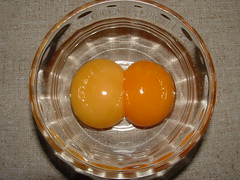 |
| drawings of unidentifiable flora from the Voynich Manuscript which is still undeciphered and wiki'ed as "the world's most mysterious manuscript" |
Err....
I've been able to console many customers with their cilantro vs. coriander dilemma (they're the same plant -- coriander is just cilantro's seed) -- but never thought to be ready to describe the difference between the two herbs. Perhaps it's a simple question, but I'm all for giving you all TMI about the difference between the two.
Can you tell the difference?
Parsley is on the LEFT. Cilantro on the right. I still have trouble telling the difference sometimes but the main thing is the shape of the leaves. The flat-leaf parsley has longer leaves whereas the cilantro is more compact... the best way to learn is to go to the store and check it out in reality.
First, they're easily confused because they are closely related, both being from the Apiaceae or Umbel family (as are carrots, celery, fennel, dill, and wild Queen Anne's lace, etc.)
As for the differences. It's hard to keep them separate in an organized-matter, so here is my attempt at organizing, hopefully not overkill:
Whew!
Ok, so -- about cilantro being soapy. There's a nice article about this, and here are a few key excerpts:
The authoritative Oxford Companion to Food notes that the word “coriander” is said to derive from the Greek word for bedbug, that cilantro aroma “has been compared with the smell of bug-infested bedclothes” and that “Europeans often have difficulty in overcoming their initial aversion to this smell.”
...
The senses of smell and taste evolved to evoke strong emotions, he explained, because they were critical to finding food and mates and avoiding poisons and predators. When we taste a food, the brain searches its memory to find a pattern from past experience that the flavor belongs to. Then it uses that pattern to create a perception of flavor, including an evaluation of its desirability.
If the flavor doesn’t fit a familiar food experience, and instead fits into a pattern that involves chemical cleaning agents and dirt, or crawly insects, then the brain highlights the mismatch and the potential threat to our safety. We react strongly and throw the offending ingredient on the floor where it belongs.
...
“When your brain detects a potential threat, it narrows your attention,” Dr. Gottfried told me in a telephone conversation. “You don’t need to know that a dangerous food has a hint of asparagus and sorrel to it. You just get it away from your mouth.”But he explained that every new experience causes the brain to update and enlarge its set of patterns, and this can lead to a shift in how we perceive a food.“I didn’t like cilantro to begin with,” he said. “But I love food, and I ate all kinds of things, and I kept encountering it. My brain must have developed new patterns for cilantro flavor from those experiences, which included pleasure from the other flavors and the sharing with friends and family. That’s how people in cilantro-eating countries experience it every day." NY Times, Why Cilantro Tastes Like Soap
Pretty cool.
Also, it's important to respect your herbs and keep them fresh. For fresh green herbs like cilantro, dill, parsley, basil, etc. once you want to store them make sure they are dry and snip off the ends. Place them in a cup or jar of clean water like flowers.
If you're going to store them in the fridge place a plastic bag over the top loosely to protect flavor. Some recommend keeping basil and parsley room-temp because they can be damaged if they get too cold and most herbs will not last as long if the leaves get damp.
Change water as needed -- can keep herbs fresh and usable for up to 2 weeks!
Consider yourself debriefed but don't get frustrated if your cilantro-parsley wires cross -- it happens.







